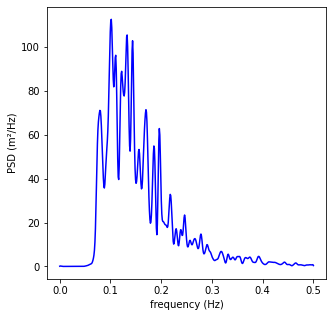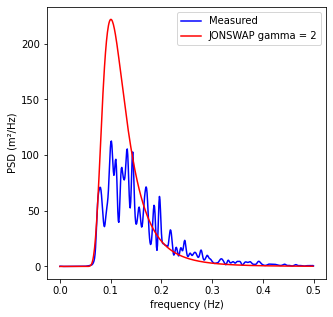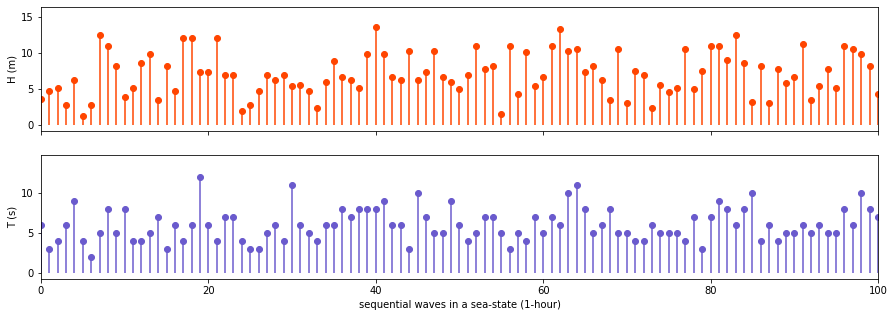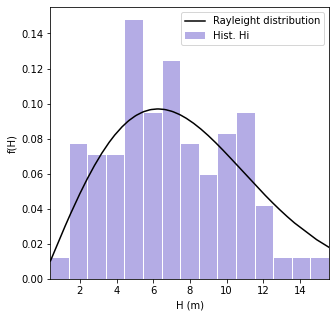Bilbao Exterior Buoy¶
# os
import os
import os.path as op
import sys
# arrays
import math
import numpy as np
import pandas as pd
from datetime import datetime
from scipy.io import loadmat
from scipy import signal as sg
# plot
import matplotlib.pyplot as plt
sys.path.insert(0, os.path.join(os.getcwd() , '..', '..', '..'))
# dependencies
if(os.path.isdir('waves-main')): #thebe
os.chdir('waves-main')
from lib.eta_spec import *
import warnings
warnings.filterwarnings("ignore")
warnings.simplefilter('ignore', np.RankWarning)
# path to buoy data
if(os.path.isdir('data')):
p_data = op.abspath(op.join(os.getcwd(), 'data', 'Bilbao')) # thebe
else:
p_data = op.abspath(op.join(os.getcwd(),'..', '..', '..', 'data', 'Bilbao')) # notebook
file = '2004_09-15.mat'
mat_file = loadmat(op.join(p_data, file))
Load data¶
# open .mat files
'''
Metadata:
L :
deltaT :
eta : Water level (mm)
north :
east :
Fecha : Matlab datenum
'''
python_datetime = [datetime.datetime.fromordinal(int(i)) + datetime.timedelta(days=i%1) - datetime.timedelta(days = 366) for i in mat_file['Fecha'][0]]
time = pd.to_datetime(python_datetime).round('H')
deltaT = np.unique(mat_file['deltaT'])[0]
# load water level series (mm)
watlev = mat_file['eta'] / 100
# select the first sea-state (17min)
seastate = '2005-03-31 04:00:00'
p = np.where(time == seastate)[0]
series = watlev[p,:][0]
time_series = pd.date_range(start=seastate, end=datetime.datetime.strptime(seastate, '%Y-%m-%d %H:%M:%S') + datetime.timedelta(seconds=1024), freq='S')[:1024]
A.1 Observations¶
plt.figure(figsize=(13,4))
plt.plot(time_series, series, color='b')
plt.xlabel('Time (1s sampling interval)')
plt.ylabel('$\eta$ (m)')
plt.xlim([time_series[0], time_series[-1]])
plt.show()

print("Mean: ", np.mean(series))
print("Standar Deviation: ", np.var(series))
Mean: -0.0028320312499999795
Standar Deviation: 9.092345495223999
A.2. Spectral Analysis¶
# Calculate spectra help(sg.welch)
f, E = sg.welch(series, fs = 1, nfft = 1024)
# Plot wave spectrum
plt.figure(figsize=(5,5))
plt.plot(f, E, c='b')
plt.xlabel('frequency (Hz)')
plt.ylabel('Densidad espectral (/Hz)')
plt.ylabel('PSD (m²/Hz)')
plt.show()

Wave spectrum parameters¶
\(m_{0}:\) zeroth-order moment of the wave spectrum
\(m_{1}:\) first-order moment of the wave spectrum
# Momento calculado con el método calc_momento
print("Zeroth-order moment: " + str(moment(0, f, E)))
print("First-order moment: " + str(moment(1, f, E)))
Zeroth-order moment: 9.813944518280783
First-order moment: 1.538209247504411
# Wave height of the zeroth order moment
print("Wave heigh: " + str(4.004 * math.sqrt(moment(0, f, E))))
Wave heigh: 12.54341721940994
# Mean frequency
print("Mean frequency : " + str(moment(1, f, E)/moment(0, f, E)))
# Wave period associated to mean frequency
print("Wave period associated to mean frequency: " + str(moment(0, f, E)/moment(1, f, E)))
# Mean zero-crossing period
print("Mean zero-crossing period: " + str(np.sqrt(moment(0, f, E)/moment(2, f, E))))
Mean frequency : 0.15673710449851574
Wave period associated to mean frequency: 6.380110205554229
Mean zero-crossing period: 5.819286177281177
# Mean energy period
print("Mean energy period: " + str(moment(-1, f, E)/moment(0, f, E)))
# Spectral width of Longuet-Higgins (1957)
# When de energy is concentrated in one single frequency, v = 0
print("Spectral width: " + str((moment(0, f, E) * moment(2, f, E)/moment(1, f, E)**2)-1))
Mean energy period: 7.501600226207497
Spectral width: 0.2020344942391914
JONSWAP Goda (1985)¶
\(S(f)=\alpha\cdot H_{s}^{2} \cdot T_{p}^{-4} \cdot f^{-5} \cdot e^{-1.25 \cdot (T_{p} \cdot f)^{-4}} \cdot \gamma^{e^{-(T_{p} \cdot f - 1)^{2}/(2 \cdot \sigma^{2})}}\)
\(\alpha \approxeq \frac{0.0624}{0.230+0.0336 \cdot \gamma - 0.185 \cdot (1.9 + \gamma)^{-1}}\)
\( \sigma=\begin{cases} \sigma_{a}; f \leq f_{p} \\ \sigma_{b}; f \geq f_{p} \end{cases} \)
\(\gamma = 1 to 7 (mean 3.3), \sigma_{a}\approxeq0.07, \sigma_{b}\approxeq 0.09\)
print('Peak frequency: ' + str(f[np.argmax(E)]))
print('Peak period: ' + str(1/f[np.argmax(E)]))
Peak frequency: 0.1015625
Peak period: 9.846153846153847
gamma, EJon = assess_jonwsap(f, E)
print('Best gamma JONSWAP fit: ' + str(gamma))
Best gamma JONSWAP fit: 2
# Plot measured wave spectrum and theorecial JONSWAP shapes
plt.figure(figsize=(5,5))
plt.plot(f, E, c='b', label='Measured')
plt.plot(f[:-1], EJon, c='r', label='JONSWAP gamma = {0}'.format(gamma))
plt.xlabel('frequency (Hz)')
plt.ylabel('Densidad espectral (/Hz)')
plt.ylabel('PSD (m²/Hz)')
plt.legend()
plt.show()

A.3 Short-term statistics¶
Definition of ‘waves’ in a time record of the surface elevation with upward zero-crossings
fs = 1
T, H = upcrossing(series, fs)
fig, axs = plt.subplots(2, 1, figsize=(15,5), sharex=True)
axs[0].vlines(range(len(H)), np.full(len(H), 0), H, color='orangered')
axs[1].vlines(range(len(T)), np.full(len(T), 0), T, color='slateblue')
axs[0].scatter(range(len(H)), H, color='orangered')
axs[1].scatter(range(len(T)), T, color='slateblue')
axs[0].set_ylabel('H (m)')
axs[1].set_ylabel('T (s)')
axs[1].set_xlabel('sequential waves in a sea-state (1-hour)')
plt.xlim(0, 100)
plt.show()

Statistical parameters¶
mean wave heigh \(\overline H\)
\(\overline H = \frac{1}{N} \sum_{i=1}^{N} H_{i}\)
where i is the sequence number (in time) of the wave in the record
root-mean-square wave height \(H_{rms}\)
\(H_{rms}=(\frac{1}{N} \sum_{i=1}^{N} H_{i}^{2})^{1/2}\)
significant wave heigh \(H_{1/3}\)
\(H_{1/3}=\frac{1}{N/3} \sum_{j=1}^{N/3} H_{j}\)
where j is the rank number of the wave, based on wave-heigh
mean of the highest one-tenth of waves \(H_{1/10}\)
\(H_{1/10}=\frac{1}{N/10} \sum_{j=1}^{N/10} H_{j}\)
mean zero-crossing wave period \(\overline T_{0}\)
\(\overline T_{0}=\frac{1}{N} \sum_{i=1}^{N} T_{0,i}\)
significant wave period \(T_{1/3}\)
\(T_{1/3}=\frac{1}{N/3} \sum_{j=1}^{N/3} T_{0,j}\)
# mean wave heigh
print("mean wave heigh: " + str(np.mean(H)))
# root-mean-square wave height
print("root-mean-square wave height: " + str(rmsV(H)))
# significant wave heigh
print("significant wave heigh: " + str(highestN_stats(H, 3)))
# mean of the highest one-tenth of waves
print("mean of the highest one-tenth of waves: " + str(highestN_stats(H, 10)))
# maximun wave heigh
print("maximun wave heigh: " + str(np.max(H)))
# mean period
print("mean period: " + str(np.mean(T)))
# significant wave period
print("significant wave period: " + str(highestN_stats(T, 3)))
# mean zero-crossing wave period
print("mean zero-crossing wave period: " + str(highestN_stats(T, 10)))
# maximun wave period
print("maximun wave period: " + str(np.max(T)))
mean wave heigh: 6.903592814371256
root-mean-square wave height: 10.743939187493275
significant wave heigh: 10.770909090909093
mean of the highest one-tenth of waves: 12.7625
maximun wave heigh: 15.600000000000001
mean period: 6.017857142857146
significant wave period: 8.357142857142863
mean zero-crossing wave period: 10.312500000000014
maximun wave period: 14.0
Wave Heigh Distribution¶
# Rayleigh distribution of individual wave heighs
fHs = [4.01 * (i/(4 * math.sqrt(moment(0, f, E)))**2) * np.exp(-2.005 * (i**2/(4 * np.sqrt(moment(0, f, E)))**2)) for i in H]
FHs = [1 - np.exp(-2.005 * (i**2/(4 * np.sqrt(moment(0, f, E)))**2)) for i in H]
# Plot - sort arrays
plt.figure(figsize=(5,5))
plt.hist(H, density = True, bins = 15, rwidth=0.95, color = "slateblue", alpha=0.5, label='Hist. Hi')
plt.plot(np.sort(H), np.array(fHs)[np.array(H).argsort()], c = "k", zorder = 10, label='Rayleight distribution')
plt.xlabel('H (m)')
plt.ylabel('f(H)')
plt.legend()
plt.xlim(np.nanmin(H), np.nanmax(H))
plt.show()

